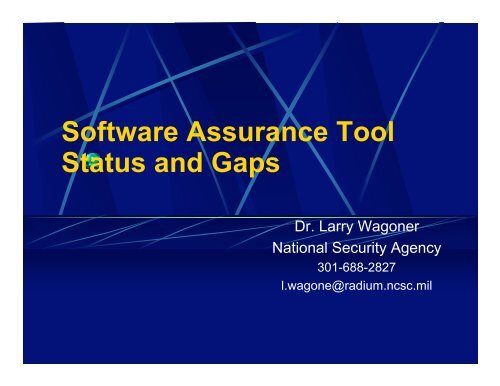NSA, Dr. Larry Wagoner - SysA
NSA, Dr. Larry Wagoner - SysA
NSA, Dr. Larry Wagoner - SysA
Create successful ePaper yourself
Turn your PDF publications into a flip-book with our unique Google optimized e-Paper software.
Software Assurance Tool<br />
Status and Gaps<br />
<strong>Dr</strong>. <strong>Larry</strong> <strong>Wagoner</strong><br />
National Security Agency<br />
301-688-2827<br />
l.wagone@radium.ncsc.mil
Outline<br />
Threat<br />
Scope/Focus<br />
Prevention<br />
Detection<br />
Reaction
The Threat<br />
There is ample opportunity to implant malicious code<br />
Malicious coder could be anyone, anywhere<br />
Adversaries can have a lot of patience and can<br />
change over time<br />
Malicious implant may be only one part of an attack<br />
Software can be attacked or exploited at any point in<br />
its life-cycle: development, distribution, operational<br />
use, maintenance<br />
Software can be attacked cheaply and with a low level<br />
of risk
Goal: Eliminate malicious code<br />
and reduce software<br />
vulnerabilities<br />
λ<br />
λ<br />
λ<br />
Software Assurance (SwA)<br />
Trojans/back doors<br />
Time and logic bombs<br />
Exfiltration<br />
Software Assurance: “The level of confidence that software is<br />
free of vulnerabilities, either intentionally or unintentionally<br />
designed or inserted during software development and/or the<br />
entire software lifecycle.”
SwA scope is the red and<br />
yellow areas<br />
Defective Software<br />
Defect Free<br />
Software<br />
● Not all defects are exploitable vulnerabilities and not all vulnerabilities are defects
Focus<br />
Focus started with intentional vulnerabilities<br />
λ<br />
λ<br />
Hardest of a hard problem<br />
Vulnerability could be disguised<br />
λ<br />
λ<br />
λ<br />
as a feature<br />
as an unintentional vulnerability<br />
anywhere in the code<br />
λ<br />
λ<br />
not just security features<br />
time bomb/logic bomb<br />
Could be inserted at any point in the lifecycle<br />
Company could be the instigator or could be<br />
a victim also
Principal Goals<br />
Maintain system availability and predictability<br />
λ<br />
λ<br />
No DOS<br />
Timely and reliable access to systems<br />
Protect Intellectual Property<br />
λ<br />
λ<br />
No exfiltration<br />
Information not disclosed to anyone unauthorized<br />
Ensure data integrity<br />
λ<br />
λ<br />
Protection against unauthorized modification or<br />
destruction of data<br />
Lose this and the data is worthless
Past Solution<br />
Air-gapped systems<br />
λ Doesn’t fully protect against data alteration<br />
or system availability<br />
λ Hard to work in a vacuum – but connectivity<br />
to other organizations leads to potential<br />
problems<br />
λ Everyone wants to and needs to be<br />
interconnected<br />
λ Except in very rare instances, not a solution<br />
anymore
Prevention<br />
Best way to fix problems<br />
Have known how to prevent for a<br />
long time, yet developers still make<br />
mistakes<br />
Little control or access into globally<br />
produced software
Prevention Needs<br />
Awareness<br />
Truly trustworthy computing base<br />
Need a business case to sell prevention<br />
New standards to protect developers<br />
from themselves<br />
Compose secure systems from<br />
independent secure components<br />
Develop more cost-effective methods for high<br />
assurance software development (and in general for low<br />
and medium assurance)<br />
Input Validation Standards<br />
Improved compilers
Improved Security through<br />
Compilers - Specifics<br />
Microsoft – deprecation of the some of<br />
the roots of buffer overflows in C and<br />
C++ in Visual Studio 2005<br />
λ string.h<br />
λ Need to phase out or make<br />
_CRT_SECURE_NO_DEPRECATE more<br />
painful to use<br />
λ Need this trend in other compilers
Detection<br />
Looking for a needle in a haystack<br />
Gray area between features and vulnerabilities<br />
Trust, but verify<br />
Important defense for<br />
malicious vulnerabilities<br />
Don’t always want to<br />
“tip your hand” that you’re<br />
examining a particular<br />
product
Detection Needs<br />
Need to move past evaluations measured in<br />
man-months as in “I had someone look at it for<br />
three months straight, so it must be good”<br />
Move toward very predictable/recreatable<br />
analysis<br />
Quick and scalable analysis - we can buy<br />
supercomputers if needed<br />
Metrics to measure “assuredness”<br />
Evaluations for software being used in specific<br />
applications
Detection Needs<br />
Improved binary and source scanning tools<br />
Dynamic vs. static analysis<br />
All tool categories have value<br />
Perfect tools?<br />
λ<br />
λ<br />
λ<br />
λ<br />
Value of tools can be rapidly diminished by too<br />
many false positives<br />
Would prefer easy to use tools with near zero false<br />
positives so developers will use the tools<br />
Don’t need to be “perfect”<br />
Incremental approach<br />
Need to independently verify claims
Reaction<br />
Looking for a needle in a hayfield<br />
Currently overwhelming admins<br />
Discovery is too<br />
late – damage is<br />
done<br />
Forensics takes a lot<br />
of resources – almost a<br />
luxury in a resource constrained<br />
environment
Reaction Needs<br />
Methods to minimize/control the<br />
functionality of products<br />
Mechanisms to detect or counter runtime<br />
exploits<br />
Reaction, by human nature, has good<br />
market demand<br />
Damage control
Summary<br />
Considerable opportunities to insert<br />
vulnerabilities<br />
Software assurance is a hard and<br />
challenging problem<br />
Perfection is not needed initially<br />
Incremental improvements<br />
Need predictable and scalable analysis<br />
tools that increase trust in software
The End.<br />
<strong>Dr</strong>. <strong>Larry</strong> <strong>Wagoner</strong><br />
National Security Agency<br />
301-688-2827<br />
l.wagone@radium.ncsc.mil
Backup
The Farewell Dossier<br />
Soviets were stealing large amounts of<br />
Western technology in the late 1970's/early<br />
1980's<br />
CIA and DoD modified products were “made<br />
available”<br />
λ Contrived computer chips found their way into<br />
Soviet military equipment<br />
λ Defective plans disrupted the output of chemical<br />
plants and a tractor factory<br />
λ Flawed turbines were installed on a gas pipeline<br />
Soviets were left to wonder what else was<br />
“customized”




